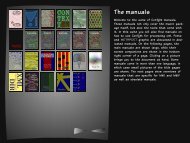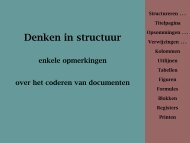ConTEXt - Pragma ADE
ConTEXt - Pragma ADE
ConTEXt - Pragma ADE
You also want an ePaper? Increase the reach of your titles
YUMPU automatically turns print PDFs into web optimized ePapers that Google loves.
Actions are for instance the already mentioned viewer controls as well as specific commands dealing<br />
with viewer data, like ResetForm, which optionally takes a comma seperated list of fieldnames. Later<br />
I will show an example if this action.<br />
Valid operations are page, program, action, or JS. The page operation replaces \gotopage, and<br />
accepts a pagenumber as well as relevant keywords. One can prefix a pagenumber by a file or url<br />
tag. The program operation replaces \gotoprogram and the action operation is compatible with<br />
the viewer specific commands.<br />
\goto {Colofon} [colofon]<br />
Also new in the next release is the possibility to chain references. When one passes a comma<br />
separated list, the references are executed one after another, which means that we can say things<br />
like goto the chapter on installation and start the movie showing how to calibrate, or:<br />
\goto {calibration} [installation,StartMovie{calibrate}]<br />
It’s no news that ConT E Xt is able to handle multi--word references and permits them to be split<br />
across lines. One can imagine that when saying things like: forget everything and exit, which was<br />
entered as:<br />
\goto {forget everything and exit} [JS(Forget_Changes),CloseDocument]<br />
one actually ends up with four times two references. Depending on the driver used, ConT E Xt tries<br />
to limit the resources, using shared objects.<br />
An operation has an argument which itself can have one or more arguments. These are passed as<br />
comma separated list between {}, like in:<br />
\goto {do something nice} [JS(something{S{alpha},V{2},V{true}})]<br />
Validation of these arguments is upto the specific action handler.<br />
JavaScript<br />
Because JavaScript support is still sort of experimental, I’ll only give some simple examples. Using<br />
scripts is a multi--step process where common functions and data structures can be shared and<br />
collected in preambles:<br />
\startJSpreamble {name}<br />
MyCounter = 0 ;<br />
\stopJSpreamble<br />
The more action oriented scripts are defined as:<br />
\startJScode {increment}<br />
MyCounter = MyCounter + 1 ; // or: ++MyCounter ;<br />
\stopJScode<br />
This script is executed with:<br />
2 up--to--date 1998/1 stripped screen version
















